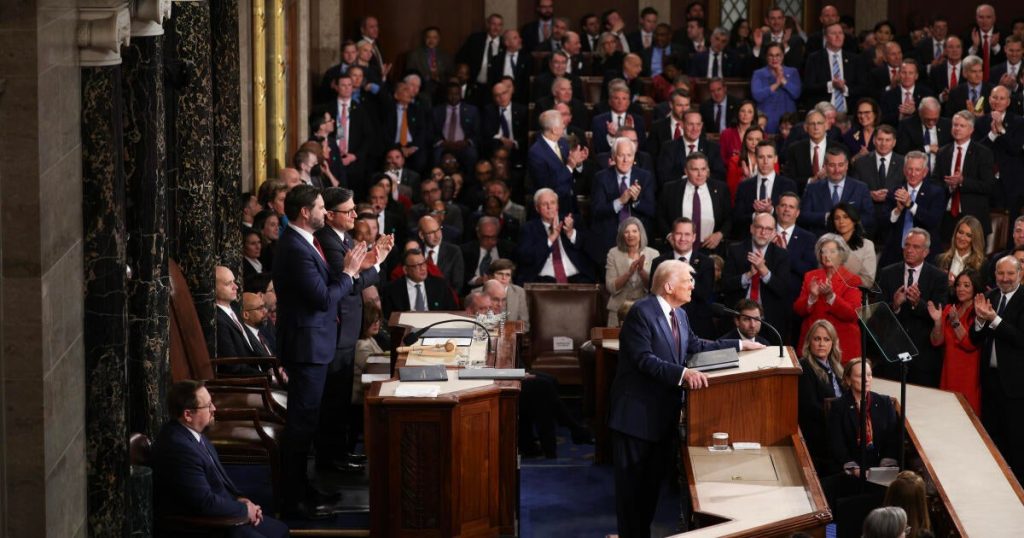A recent survey conducted by YouGov revealed that a significant majority of viewers responded positively to President Trump’s latest address to Congress. The polling, following his speech, showcased a largely Republican audience, who expressed approval of Trump’s topics and execution. The findings highlighted a divide in sentiments, with Democrats feeling more alarmed than encouraged by the President’s proposals and rhetoric.
| Article Subheadings |
|---|
| 1) Overview of the Audience Response |
| 2) Key Topics Highlighted in the Speech |
| 3) The Emotional Reactions of Viewers |
| 4) Political Divide Among Viewers |
| 5) Implications for Future Political Discourse |
Overview of the Audience Response
The CBS News/YouGov survey, which involved 1,207 interviews of individuals who watched President Trump’s address, revealed substantial approval ratings among viewers. Predominantly Republican respondents indicated high levels of satisfaction, with many describing Trump’s demeanor as “presidential,” “inspiring,” and “unifying.” This is characteristic of typical viewership patterns during presidential speeches, where supporters from the incumbent’s party are more likely to report favorable impressions. The survey underscores the strong partisan nature of political media consumption, especially in the context of the current political climate.
Key Topics Highlighted in the Speech
Among the topics addressed by President Trump, economic concerns, immigration policies, and government accountability were particularly resonant with viewers. Approximately two-thirds of the audience felt that Trump had articulated a clear plan to address economic issues, particularly those related to rising prices. Such perceptions are critical as viewers exit a major speech with expectations of hearing substantive proposals rather than mere rhetoric. Additionally, Trump’s remarks on immigration drew substantial approval, showcasing a perceived alignment with the viewers’ priorities.
The Emotional Reactions of Viewers
The emotional reactions to Trump’s speech varied significantly, with a notable number of viewers expressing feelings of “hope” and “pride.” Many reported that the speech aligned closely with critical issues they cared about, fostering a sense of optimism. In stark contrast, viewers from the opposing party expressed feelings of anxiety, with 40% indicating anger in response to his remarks. This juxtaposition of emotional responses reflects not only the charged political atmosphere but also the rhetorical strategies employed by the President, which often evoke passionate reactions based on ideological lines.
Political Divide Among Viewers
The political divide was evident not just in emotional responses but also in perceptions of the President’s attempts to address contentious issues. While many viewers lauded Trump for his supposedly accurate portrayal of crime-related statistics, Democrats present felt increasingly alarmed by the narratives presented. This dichotomy showcases the broader challenges in political communication and the difficulty in constructing a cohesive national narrative that resonates across party lines. The reactions point to a deep-seated cognitive dissonance often experienced in highly partisan environments, influencing public opinion and voting behaviors.
Implications for Future Political Discourse
Trump’s speech may carry implications beyond immediate audience reactions, perhaps shaping the landscape for future political discussions. The approval ratings and sentiments reflected in the survey could have repercussions for legislative initiatives and electoral campaigns moving forward. With a significant percentage of viewers acknowledging the President’s points on immigration and government spending, this could inform party strategies in the run-up to upcoming elections. The responses illustrated the importance of addressing constituents’ concerns in a manner that fosters a sense of pride and inclusiveness, particularly as both parties begin to strategize for the future.
| No. | Key Points |
|---|---|
| 1 | Majority of viewers approved of President Trump’s address. |
| 2 | Key topics included economic issues and immigration policies. |
| 3 | Emotional responses varied significantly by party affiliation. |
| 4 | Political reactions indicate a divide on key issues among viewers. |
| 5 | Future political discourse may be shaped by viewer sentiments. |
Summary
The aftermath of President Trump’s address to Congress demonstrates the deep divisions in political sentiment within the United States. While his rhetoric and proposals found favor among Republican viewers, the dismay expressed by Democrats underscores the challenges of unifying discourse in a polarized political landscape. As administrations evolve and campaign strategies develop, the insights gleaned from this survey will likely play a critical role in shaping future engagements between the government and constituents, with an eye towards addressing the key issues that resonate within the electorate.
Frequently Asked Questions
Question: What was the primary focus of President Trump’s address to Congress?
President Trump’s address primarily focused on economic concerns, immigration policies, and government accountability, which resonated strongly with his Republican audience.
Question: How did viewers from different parties react to the speech?
Republican viewers largely reacted positively, feeling hopeful and confident, while Democratic viewers reported feelings of worry and anger regarding the content of the speech.
Question: What does the audience approval mean for future political actions?
The approval of President Trump’s address may influence future legislative priorities and campaign strategies, particularly emphasizing the importance of addressing constituents’ concerns effectively.


